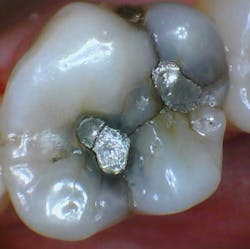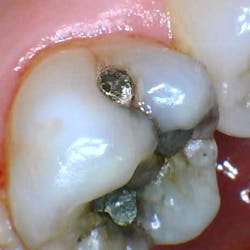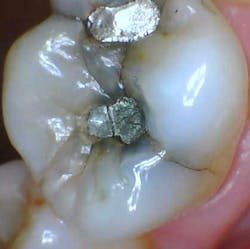As I see it, here’s the conundrum: presenting said culprit to patients so they understand that the status quo isn’t healthy. Lack of pain, pathology, and stereotypical skepticism means hesitation on the patients’ part, even when a picture packs more than a thousand words.
Let’s paint the scenario for this particular tooth:
- 62-year-old female, new-patient exam/full assessment
- Asymptomatic tooth no. 14
- Arguably conservative lingual/mesial/distal pit occlusal amalgams with a small fracture on the mesial restoration
- Noted fracture lines across the transverse and mesial marginal ridges as well as lingual and buccal grooves
- Amalgam salt leakage/staining of the tooth with likely caries that’s not clinically or radiographically evident, especially where the amalgam is cracked
My point to the patient: the restoration is compromised but with the presence of the crack lines, concern for the overall long-term functional integrity of the tooth is warranted unless a full-coverage restoration is placed; anything less would give rise to the potential for additional cracking, breakage, pulpal involvement, and possibly even extraction.
How do you present this kind of picture to a patient who may be skeptical of what we, as dentists, do in the first place? I’ve ridden this rodeo on both sides of the fence—some patients jump right in for a crown and others look at me and say, “If it’s not broken, I ain’t gonna fix it.” Sometimes, when I treat the tooth, that fracture line is oh-so-ugly (mesial/distal or buccal/lingual cracks across the floor of the prep), and ultimately the tooth becomes symptomatic, endo is recommended, and even on rare occasion, the tooth is pulled. Patients always circle back and say, “It wasn’t bothering me before you wanted to get your hands on it...”
Ugh! I get why patients are skeptical of dentists. I’d be skeptical, too, but to play devil’s advocate, would it be worse if we didn’t tell them about what is going on in their mouth, advise accordingly, and allow them to proceed as they see fit? Is ignorance really bliss? Would an “informed refusal” hold up in this case? How about this question: is this the type of scenario that separates our dental personalities from one another (i.e., aggressive versus nonaggressive treatment)? Chew on that one for a bit…
So, what have you done in the past in cases like this? We can both agree that the practice of oral medicine is fluid and that every patient/tooth/situation is unique and requires individualized attention. There has to be a dialogue that covers all of the bases without making us look like we’re just wanting to pad our pockets and water the mistrust that blankets our profession. We all know that dentistry has its fair share of “bad apples,” but it doesn’t mean that as a whole we don’t collectively have the best interests of all of our patients at the forefront of what we do.
Please shed some light on this matter for me, because I think it’s worthy of a candid discussion. I’ll pass your words of wisdom along to the forum, and they will help us all be better dentists and do better dentistry—or, at the very least, we’ll gain an understanding and respect for the varied perspectives in this gray area of clinical and patient management.
Always keeping it real, raw, and honest. Cheers! S
Editor’s note: This article first appeared in Through the Loupes newsletter, a publication of the Endeavor Business Media Dental Group. Read more articles at this link and subscribe here.
Stacey L. Gividen, DDS, a graduate of Marquette University School of Dentistry, is in private practice in Hamilton, Montana. She is a guest lecturer at the University of Montana in the Anatomy and Physiology Department. Dr. Gividen is the editorial co-director of Through the Loupes and a contributing author for DentistryIQ, Perio-Implant Advisory, and Dental Economics. She serves on the Dental Economics editorial advisory board. You may contact her at [email protected].








